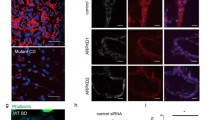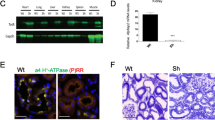Abstract
Glucose-6-phosphatase is a multicomponent endoplasmic reticulum system comprising at least six different proteins, including a lumenal enzyme and several transport proteins. One of the transport proteins, T2β, transports the substrate pyrophosphate and the product phosphate and its genetic deficiency is termed type 1c glycogen storage disease. We have used anti-T2β antibodies for immunohistochemistry with image analysis and kinetic analysis of the glucose-6-phosphatase system to study for the temporal and spatial development of T2β in human embryonic and fetal kidney. In metanephric kidney, there is an early predominance of T2β expression in the ureteric bud derivatives and this changes with ontogeny such that developing nephrons, particularly proximal tubules, become dominant by mid-gestation. T2β has the same spatial and temporal pattern as the glucose-6-phosphatase enzyme in both mesonephric and metanephric kidney. Pyrophosphate transport capacity is appropriate for the amount of glucose-6-phosphatase activity present in mid-gestation fetal kidney, in contrast to liver, where pyrophosphate transport capacity is developmentally delayed. Increasing knowledge of the temporal and spatial expression of the glucose-6-phosphatase proteins and their catalytic roles in early human development is essential for the elucidation of the aetiology of renal disease in both type I glycogen storage diseases and the developmental disorders of the glucose-6-phosphatase system.
Similar content being viewed by others
References
Alon US, Scagliotti D, Garola RE (1994) Nephrocalcinosis and nephrolithiasis in infants with congestive cardiac failure treated with furosemide. J Pediatr 125: 149–151
Arion WJ, Ballas LM, Lange AJ, Wallin BK (1976) Microsomal membrane permeability and the hepatic glucose-6-phosphatase system. J Biol Chem 251: 4901–4907
Arion WJ, Lange AJ, Walls HE, Ballas LM (1980) Evidence for the participation of independent translocases for phosphate and glucose-6-phosphate in the microsomal glucose-6-phosphatase system. J Biol Chem 255: 10396–10406
Ashmore J, Weber G (1959) The role of hepatic glucose-6-phosphatase in the regulation of carbohydrate metabolism. Vitam Horm 17: 91–132
Bell JE, Hume R, Busuttil A, Burchell A (1993) Immunocytochemical detection of microsomal glucose-6-phosphatase in human brain astrocytes. Neuropathol Appl Neurobiol 19: 429–435
Burchell A (1992) The molecular basis of the type 1 glycogen storage diseases. Bioessays 14: 395–400
Burchell A, Cain DI (1985) Rat hepatic microsomal glucose-6-phosphatase protein levels are increased in streptozotocin-induced diabetes. Diabetologia 28: 852–856
Burchell A, Hume R, Burchell B (1988) A new microtechnique for the analysis of the human hepatic microsomal glucose-6-phosphatase system. Clin Chim Acta 173: 183–192
Burchell A, Gibb L, Waddell ID (1989) New microtechniques for the diagnosis of the type 1 glycogen storage diseases. In: Depuy C, Valette L (eds) Perinatal prevention of genomic anomalies. Foundation Marcel Merieux, Lyon, pp 96–103
Burchell A, Gibb L, Waddell ID, Giles M, Hume R (1990) The ontogeny of the human hepatic glucose-6-phosphatase proteins. Clin Chem 36: 1633–1637
Burchell A, Lyall H, Busuttil A, Bell J, Hume R (1992) Glucose metabolism and hypoglycaemia in SIDS. J Clin Pathol 45 [Suppl: 39–45
Burchell A, Allan BB, Hume R (1994) The endoplasmic reticulum glucose-6-phosphatase proteins. Mol Membr Biol 11: 217–227
Chen Y-T (1991) Type I glycogen storage disease: kidney involvement, pathogenesis and its treatment. Pediatr Nephrol 5: 71–76
Chen Y-T, Burchell A (1995) Glycogen storage diseases. In: Scriver CR, Beaudet AL, Sly WS, Valle D (eds) The metabolic basis of inherited disease, chapter 24. McGraw-Hill, New York, pp 935–965
Chen Y-T, Coleman RA, Scheinman JI, Kolbede PC, Sidbury JB (1988) Renal disease in type I glycogen storage disease. N Engl J Med 318: 7–11
Colquhoun D (1971) Lectures on biostatistics. Clarendon Press, Oxford, pp 257–265
Cori GT, Cori CF (1952) Glucose-6-phosphatase of the liver in glycogen storage disease. J Biol Chem 199: 661–667
Fulceri R, Romani A, Pompella A, Benedetti A (1990) Glucose-6-phosphate stimulation of MgATP-dependent Ca2+ uptake by rat kidney microsomes. Biochim Biophys Acta 1022: 129–133
Hume R, Burchell A (1993) Abnormal expression of glucose-6-phosphatase in preterm infants. Arch Dis Child 68: 202–204
Hume R, Lyall H, Burchell A (1992) Impairment of the activity of the microsomal glucose-6-phosphatase system in premature infants. Acta Paediatr 81: 580–584
Hume R, Bell JE, Hallas A, Burchell A (1994) Immunohistochemical localisation of glucose-6-phosphatase in developing human kidney. Histochemistry 101: 413–417
Hume R, Voice M, Pazouki S, Giunti R, Benedetti A, Burchell A (1995) The human adrenal microsomal glucose-6-phosphatase system. J Clin Endocrinol Metab 80: 1960–1966
Lucius RW, Waddell ID, Burchell A, Nordlie RC (1993) The hepatic glucose-6-phosphatase system in Ehrlich-ascites-tumour-bearing mice. Biochem J 290: 907–911
Nordlie RC (1976) Glucose-6-phosphate phosphotransferase. In: Mehlman MA, Hanson RW (eds) Gluconeogenesis: its regulation in mammalian species. Wiley, New York, pp 93–152
Nordlie RC (1985) Fine tuning of blood glucose concentrations. Trends Biochem Sci 10: 70–78
Nordlie RC, Scott HM, Waddell ID, Hume R, Burchell A (1992) Analysis of human hepatic microsomal glucose-6-phosphatase in clinical conditions where the T2 pyrophosphate/phosphate transport protein is absent. Biochem J 281: 859–863
Oh W (1981) Renal functions and clinical disorders in the neonate. In: Lewy JE (ed) Symposium on perinatal nephrology. Saunders, Philadelphia, pp 215–223
O'Rahilly R, Muller F (1987) Developmental stages in human embryos. (Publication 637) Carnegie Institution of Washington, Washington, DC
Pears JS, Jung RT, Hopwood D, Waddell ID, Burchell A (1992) Ten cases of symptomatic adult hypoglycaemia due to hepatic glycogen metabolising abnormalities. Q J Med 299: 207–222
Peterson GL (1977) A simplification of the protein method of Lowry et al. which is more generally applicable. Anal Biochem 83: 346–356
Potter EL (1972) Normal and abnormal development in the kidney. Year Book Publishers, Chicago
Restaino I, Kaplan BS, Stanley C, Baker L (1993) Nephrolithiasis, hypocitraturia, and a distal renal tubular acidification defect in type I glycogen storage disease. J Pediatr 122: 392–396
Scammon RE, Calkins LA (1929) The development and growth of the external dimensions of the human body in the fetal period. University of Minnesota Press, Minneapolis
Sternberger LA, Hardy PH, Cuculis J, Meyer HG (1970) The unlabelled antibody method of immunohistochemistry: preparation and properties of soluble antigen — antibody complex (horseradish peroxidase-anti-horseradish peroxidase) and its use in identification of spirochaetes. J Histochem Cytochem 18: 315–333
Waddell ID, Lindsay JD, Burchell A (1988) The identification of T2: the phosphate/pyrophosphate transport protein of the hepatic microsomal glucose-6-phosphatase system. FEBS Letts 229: 179–182
Author information
Authors and Affiliations
Rights and permissions
About this article
Cite this article
Hume, R., Brewerton, H. & Burchell, A. The human embryonic-fetal kidney endoplasmic reticulum phosphate-pyrophosphate transport protein. Vichows Archiv A Pathol Anat 427, 575–582 (1996). https://doi.org/10.1007/BF00202888
Received:
Accepted:
Issue Date:
DOI: https://doi.org/10.1007/BF00202888




